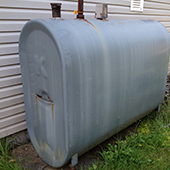 Oil spills can be enormously costly and create extensive environmental damage. Often homeowners must cover all cleanup costs since most house insurance policies don’t cover oil spills. Additionally, homes using oil for heating have very high greenhouse gas emissions and therefore a bigger impact on climate than other heating fuel choices. Rebates are available to switch from oil and other fossil fuels to a heat pump. Help protect local waterways, the global climate, and save energy on your heating bills by replacing oil heating with a heat pump!
Oil spills can be enormously costly and create extensive environmental damage. Often homeowners must cover all cleanup costs since most house insurance policies don’t cover oil spills. Additionally, homes using oil for heating have very high greenhouse gas emissions and therefore a bigger impact on climate than other heating fuel choices. Rebates are available to switch from oil and other fossil fuels to a heat pump. Help protect local waterways, the global climate, and save energy on your heating bills by replacing oil heating with a heat pump!
Avoid spills. Regularly inspect your oil tank and equipment and remove underground tanks that you don’t use.
Find out if there is an oil tank on your property
We have some historical records of oil tank installations and removals.
Contact us by phone to find out if we have any information about your property.
Removing or altering an oil tank or equipment on your property?
For detailed requirements, please read our Oil Burning Equipment and Flammable Liquid and Combustible Liquid Fuel Tank Bylaw,9265, 9344 and 9700.
In short, you need:
- A permit from the Fire Department.
- Trained personnel to carry out the work.
- New installations require new tanks (existing tanks less than 5 years old on same property may be relocated subject to approval of Fire Department).
- A Fire Department inspection of that work within 14 days.
In addition, the bylaw requires underground tanks that you don’t use or that have been out of service for more than two years to be removed. All underground tank removal permits require soil testing to be conducted by a certified environmental engineer to determine if contaminates are present.
Through the soil testing process, a certified environmental engineer prepares a report on the soil testing results. A copy of the soil testing report is to be delivered to the Fire Department prior to the approval of your oil tank removal permit.
If contamination is found during the soil testing, the homeowner will be required to remediate contaminated soil surrounding the fuel tank by replacing the soil around and under the fuel tank with clean fill. A copy of the environmental engineer's report stating successful remediation is to be forwarded to the Fire Department upon completion.
Oil tanks rendered inactive with a permit from the Fire Department before the adoption of Bylaw 9265 on May 26, 2014 are exempt from this requirement. However, insurance and financial institutions may require homeowners to remove any inactive tanks before they will approve home insurance or mortgage agreements.
More Information
- Installation Code for Oil-Burning Equipment – CAN/CSA-B139-09, A National Standard of Canada (2019)
- 2018 B.C.Building Code and 2018 B.C. Fire Code
- Managing Residential Oil Heat Systems in the Capital Regional District, A Review of Stakeholder Views and Actions Concerning Prevention of Fuel Spill Oils, The Partnership for Water Sustainability in B.C., September 19, 2014
- Facts on Contaminated Sites, B.C. Ministry of Environment
- Environmental Code of Practice for Aboveground and Underground Storage Tank Systems Containing Petroleum and Allied Petroleum Products, Canadian Councils of Ministers of the Environment
- Homeowner's Guide: Home Heating Oil Tanks, Capital Regional District Environmental Protection

